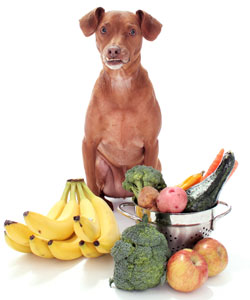More on Dog Anal Gland Care
You might have seen one of the many videos online where a dog is scooting his butt across the floor in a most humorous way. Not only is it unfair to the dog, who has no idea millions of people are laughing at his expense, it’s also a sign of a potentially serious problem – infected anal glands.

Anal glands are a dog’s calling card — they emit some fluid when pressured by urinating or defecating and that same fluid has your dog’s own unique smell. They can also release the smell when a dog is excited, as when meeting another dog. If the glands aren’t expressed naturally and regularly, they become impacted which can lead to infection or even a rupture.
Regular Care of the Anal Glands
Some dogs never have a problem with their anal glands so it’s up to you to be aware of the warning signs. The famous scoot across the floor is a good indication that your dog needs his anal glands expressed. Other signs are a fishy odor around your dog’s behind or soft stool.
The Role of Nutrition
By feeding your dog quality dog food with fewer cereal fillers, he will likely produce firmer stools, which will naturally express the anal glands. Be sure to check with your vet before starting any supplements.
Having a Professional Express the Glands
This is really recommended as an expert is less likely to hurt your dog and can do it quickly and efficiently. You can bring your dog to the vet to get the glands expressed when you notice a sign that they’re impacted. You can also bring him to a professional groomer. A groomer is a good choice because she likely sees your dog every few months and, thus, there’s less time that the glands are going unchecked.
Doing It Yourself
This is not recommended, but if you have no other option but to express the glands yourself, here are some simple instructions. The key is to be calm, prepared, and as quick as possible as this is not a pleasant experience for your dog. First, locate the glands. They are at about five and seven o’clock on either side of his anal opening. Next, wearing latex gloves, apply firm but gentle pressure to the glands. Hold a warm cloth over the opening to prevent a squirt of the nasty fluid. Some fluid should be expelled from the opening. Do not repeat the process; simply wipe your dog with the washcloth and reward him.
Vegetables For Dogs

As with all dog food items, portion size is important. Keep your dog’s veggie treats small and talk to your vet about adjusting your dog’s food intake if you are supplementing your dog’s diet with vegetables. Vegetables may be low in calories, but they are not zero calories. Also make sure your dog does not choke on the vegetable in the excitement of eating them.
Watch out for any adverse reaction, such as nausea or loose stools. Sometimes vegetables will cause gas in your dog, so don’t overdo the amount you give him. If you are giving your dog the vegetable for the first time, give him just one small piece and observe his reaction before increasing the size or amount.
There are many ways to serve vegetables for your dogs other than raw, such as cooked, steamed, baked, roasted, grilled or dehydrated. Dogs do enjoy vegetables raw as a yummy treat; however, they have short digestive systems and do not get as many nutrients out of eating vegetables raw as we humans. A good way for dogs to get the full nutrients of the vegetables is to break them down in a pureed form. No matter how you prepare the vegetables for your dogs, do not use salt. Dogs don’t always care for it and it is not good for dogs with heart conditions.
The following are 11 safe, good vegetables for dogs, with suggested cooked preparations and portion sizes for treats.
Asparagus
Preparation: Remove the fibrous ends from the asparagus spears and wash them thoroughly. Toss them with olive oil and grill 30 to 60 seconds on all sides.
Dog treat portion size: Cut into bite size pieces. Feed one to two pieces.
Benefits: Great source of Vitamin K. Good source of Vitamins A, B1, B2, C and E, folate, iron copper, fiber, manganese and potassium.
Broccoli florets
Preparation: Cut broccoli into small florets and wash thoroughly. Place in a steamer and follow the directions. Using a stove, put florets in an open vegetable steamer in a pot with boiling water and cover. Steam for about 6 to 8 minutes until crisp yet tender and bright green. You can also microwave them by putting 2 cups of broccoli florets in a microwave-safe container along with an inch of water for about 5 minutes.
Dog treat portion size: One or two bite size florets
Benefits: Great source of Vitamins C and K. Good source of Vitamin A, folate, manganese and fiber.
Brussels sprouts
Preparation: Choose Brussels sprouts that are green, feel firm and don’t smell too strong. Wash thoroughly and cut off the stems, leaving enough stem that the leaves are still intact. Some chefs advise cutting a little X to in the stem to help the core to cook. You can then microwave the sprouts with water for up to 8 minutes, steam them for 5 minutes or boil the sprouts for up to 10 minutes – a little less for more crunchiness.
Dog treat portion size: 1/2 to 2 sprouts, depending upon the dog’s size
Benefits: Great source of vitamins K and C. Good source of manganese, folate, fiber, potassium and vitamins A, B1 and B6.
Carrots
Preparation: Remove ends and thoroughly wash. Cut into bite size treats and cook in a pot of boiling water for about 10 minutes or steam for two to six minutes until tender.
Dog treat portion size: One or two bite size pieces
Benefits: Great source of vitamin A. Good source of vitamins K and C, fiber and potassium.
Cauliflower
Preparation: Wash thoroughly. To grill the cauliflower, leave a little stalk intact. Marinate the cauliflower for 30 minutes in olive oil and then grill for 5 to 6 minutes on each side until crisp yet tender.
Dog treat portion size: 1 to 2 florets, depending on the dog’s size
Benefits: Great source of vitamin C. Good source of vitamins K and B6, folate and choline.
Cucumbers
Preparation: Wash thoroughly, peel, cut in half and remove seeds. Cut into bite size pieces. Place pieces into pot with boiling water for about 5 minutes. Empty pot into strainer. If the cucumbers are a bit bland, you can add dog-safe seasoning. (No salt)
Dog treat portion size: 1 to 2 bite size pieces
Benefits: Good source of vitamin K.
Edamame
Preparation: Edamame is conveniently available as a frozen vegetable in your local food store. Steam these boiled green soy beans according to the directions on the bag.
Dog treat portion size: One to five unsalted, out-of-shell beans. Note: Always watch your dog eat small food items as he could choke on them in his excitement to gobble them down.
Benefits: Great source of protein, iron, fiber, vitamin K, Omega-3 fats, phosphorus, vitamin B2, potassium, copper and magnesium.
Green beans
Preparation: Wash thoroughly and cut off ends. Use a covered pot to cook green beans in boiling water for about 10 minutes. Serve when cool. You can also cook green beans, brown rice and chicken in chicken broth to serve dogs with an upset tummy.
Dog treat portion size: 1 to 2 bite size pieces
Benefits: Good source of vitamins C, K and A, manganese and fiber.
Peas
Preparation: Fresh peas are usually available as snow, sugar snap or English peas. English peas must be shelled. Snow and sugar snap peas’ shells are edible. You can grill sugar snap and snow peas for about 3 minutes on each side, first lightly coating with olive oil if you prefer. For English peas, you need to shell them first. Cook the peas (minus their pods) in boiling water only two to four minutes until they turn bright green. Drain in a colander.
Dog treat portion size: One or two Sugar snap or snow peas. For English, 1 or 2 tablespoons – depending on the dog’s size
Benefits: Great source of vitamin K, and C. Good source of manganese, fiber, folate, phosphorus, protein, magnesium, copper, iron, zinc, potassium and vitamins B1, A, B6, B3 and B2.
Sweet potatoes
Preparation: Sweet potatoes make a great chew if you dehydrate them. Cut them lengthwise, 1/4-inch thick. Just follow the vegetable dehydration instructions included your dehydrator. You can also feed your dog mashed sweet potatoes. To prepare, peel and wash potatoes. Cut into quarters. Put into boiling water in a large pot and simmer for about 20 minutes. Test potatoes with a fork. When they are fully tender, remove from pot, place in a heat-resistant container and mash with a potato masher.
Dog treat portion size: Half or one dehydrated chew, depending on size of dog. Mix 1 to 2 tablespoons of mashed sweet potato in dog’s dry dog food.
Benefits: Great source of vitamin A. Good source of vitamins C, B6 and B5, manganese, potassium and fiber.
Potatoes
Preparation: Wash thoroughly, and slice into narrow wedges. Don’t peel the potato. Coat with a little olive oil and place on cookie sheet. Roast in oven (425 degrees Fahrenheit) for at least 20 minutes on each side. Roast longer if your dog likes them crispier.
Dog treat portion size: 1 or 2 wedges, depending on dog’s size
Benefits: Good source of vitamins C and B6, potassium, manganese and fiber. Remember, too, that there are some vegetables you should not feed to your dog. Never offer your dog onions or fresh garlic. Talk to your veterinarian if you have questions or concerns regarding vegetables and your dog’s diet.





